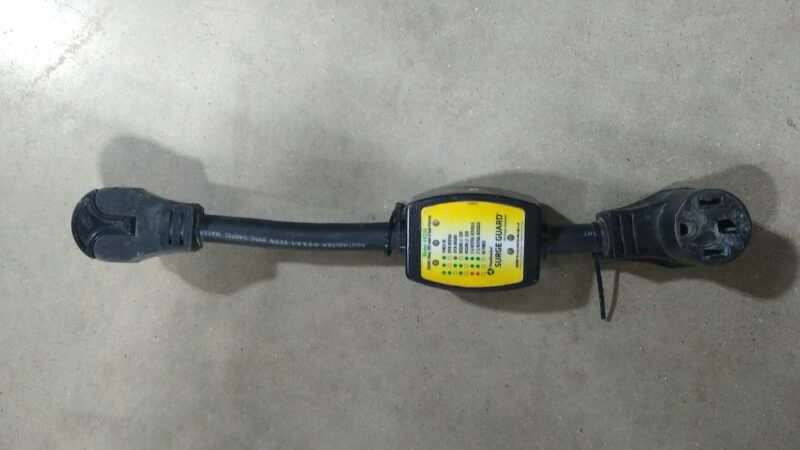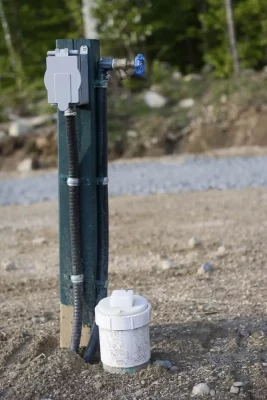If you are an intelligent person – and as a Reader of this blog, you most unquestionably are – then you use an advanced surge protector to test the power at every campsite pedestal before plugging in.
It is quite possible – dare I say even likely – that at some point you will shake the EMS and mutter to yourself, “Broken piece of junk,” because the voltage reading will be far too low to be believable. “99 volts? As if!”
Don’t blame the surge protector. It’s just doing its job, and it’s not broken. Blame the campground. Or more accurately, blame all your neighbors for cranking their air conditioners up to High on Cool mode. Or stick it to the Man, and blame the campground for staying stuck in the 1980s.
Let’s talk about campground low voltage.
What Causes Low Voltage in an RV Campground?
Low voltage at a campsite normally happens because the campground wiring is insufficient to handle peak loads. Generally, this means the branch circuit wiring is too small.
Maybe it wasn’t always too small. But nowadays, with your 32-ft RV running two air conditioners, a TV, residential-sized fridge, laptop, water heater, and dinner warming up in the microwave – well, it’s a far cry from your Grandpa’s vintage Shasta.
This is because of loopholes in NEC calculations that allowed the campground to size the circuit design based on partial use. But at 100% occupancy, 100% power, that assumption falls apart. The NEC does NOT regulate maximum voltage drop at an RV campground!
As an example: Prior to 2005, only 5 percent of a campground’s pedestals had to offer 50A power. By 2017, that number had leapfrogged to 40 percent! Campgrounds from the 20th century just weren’t designed with today’s greedy 50A motorhomes in mind.
The fix is easy: Dig up the campground, dig a trench, open the conduit, run new cable, and put Humpty Dumpty back together again –
– except, as you can imagine, most campground owners aren’t thrilled about spending their life savings on a new AC distribution system. (Which, in the end, I’m sure you as the customer would pay for.) So, the old wiring stays.
There are other possible causes of low voltage at a campsite.
- Sometimes, it means the local power company has a “brownout” problem, where they allow the grid voltage to drop too low, but that’s fairly rare in the United States. Most utilities maintain the line voltage at 120-125 volts (it’s crept up over time). If you suspect a brownout condition, call the power company.
- It could also mean that the utility installed an undersized transformer to service the campground, trying to save money. That seems to be the most common problem other than insufficient wire size and circuit design.
What Happens to My RV If the Campground Voltage Is Too Low?

If you try to operate your RV on electricity with unacceptably low voltage, a few things will happen.
- Appliances that make heat (toasters, coffee makers, water heaters, etc.) will take longer to do their job. Generally, they won’t be as hot.
- Appliances with induction motors (AC refrigerators, dryers, etc.) will draw more current (amps) than usual. This can trip a breaker or overheat the motor.
- You might burn out the compressor on your air conditioner.
You might see an overall lack of performance, especially in the cooling performance of your AC fridge and air conditioner. In extreme circumstances, low voltage can cause fires, but that’s rare.
What Happens if Low Voltage Kills My RV?
What happens if you fry your air conditioner? Blow out your microwave?
You could go file a complaint with the campground owner, but you are likely to be told non est mihi quaestio, aka, not my problem.
Plus, many campground owners and hosts don’t know a volt from an amp. You may be told, “No one else has ever had a problem.”
How Can You Escape to Higher Voltage?
If you’re currently parked at a campsite, and you’re desperate for a fix, and you don’t have time to order something off Amazon, then here’s what you can do … right now!
- Use a shorter power cord. The longer the cord, the more voltage drops.
- Move campsites. Typically, the campsite at the end of a branch circuit sees the lowest voltage. There are usually 6-10 sites per branch circuit; move to one closer to the source! Better yet, get as close to the main transformers as you can.
- Get a 50A campsite. Sites with 50A electrical hookups tend to be newer, and therefore the wiring will often be large enough to deal with peak power demands. Use an adapter if you have a 30A power connection.
- Wait until night. Typically, campground voltages are higher during off-peak hours.
- Use propane where possible. Switch your water heater and refrigerator to propane mode if you can. For that matter, your water heater works better on propane, anyway.
- Set your thermostat higher. Put your air conditioner on Low or Medium mode and set your thermostat temperature just a few degrees higher.
- Run a generator. If you don’t trust the campsite power, just make your own! Plug in that generator and let ‘er rip!
Will a Surge Protector Fix Low Voltage?

No. Even advanced surge protectors don’t boost voltage. They just act as gatekeepers. If the supply voltage is too low, they’ll shut off power to protect your RV, but they can’t fix the problem.
But there is someone that can …
You Need an Autoformer!
Let’s introduce our caped hero: the autoformer!

Autoformers are also known as voltage regulators or voltage boosters. They’re essentially “smart” step-up transformers. They are nifty devices that trade current (amps) for volts (energy).
Autoformers increase voltage. Most will automatically boost low voltages by 10 percent up to 118 volts maximum. So if you put 100 volts into an autoformer, you’ll get 110 volts out. Your air conditioner will work more efficiently; your toaster will toast faster.
Generally, you install an autoformer between your power pedestal and your surge protector. Check your Owners Manual for instructions.
Some RV owners hardwire their autoformers inside their RV where they can’t be stolen. Others secure them with a cable lock to the power pedestal.
How an RV Autoformer Works (an Example)
Here are the big takeaways on how an RV autoformer works:
- Most autoformers boost low voltages by 10%
- Except, above 118 volts input, the boost will only be 2%
The most well-known manufacturer of RV voltage boosters is Hughes. They make 30A and 50A versions.
Now, let’s get into an example:

Say you reserve a 30A campsite. And you plug in your surge protector and notice that the voltage at the power pedestal is only 102 volts.
Well, that’s not good. Most surge protectors will automatically shut off power if the voltage falls that low! So what do you do?
You plug in your autoformer, of course! And it will automatically boost the voltage by 10%, so now you’re using electricity at 112.2 volts. That ain’t great, but it’s safe. So you go inside, crank up the A/C, warm up some pizza, and enjoy your life.
Now, remember, you are limited to 30 amps total. There’s nothing magical in an autoformer that changes that. If you draw more than 30 amps, you will trip the circuit breaker at the power pedestal. End of story.
So what happens if you turn on two high-efficiency 13k BTU air conditioners, which draw 12.5 amps each, and a 700-watt microwave, which draws 5 amps?
12.5 + 12.5 + 5 = 30 amps! Hurray, you’re good to g-
Wait, no you’re not. Remember that autoformer? You made a deal. You traded current for voltage. You no longer have 30 amps available at the RV. Get that?
I’ll repeat it again because it’s so important: Because your autoformer boosted your voltage, you can draw 30 amps from the power pedestal, but you can’t draw 30 amps at the RV itself.
I try to avoid math on this blog, so let’s not get into exactly how many amps less you may have. That depends on how many inductive and resistive loads you’re running simultaneously, and honestly, it doesn’t matter that much.
You just need to understand that you might not be able to run everything you’re used to when plugged into an autoformer – but what you can run is safer and more efficient.
Does an RV Autoformer Steal Voltage From Your Neighbor?
Now, let me address the elephant in the room.
Some people will argue that using an autoformer “steals” voltage from the rest of the campground. Which makes you, the user, an unethical thief.
Let me try to shed some light on this controversial topic. And let’s use our words carefully because power isn’t current isn’t energy (although I’m guilty of carelessly bandying these words myself.)
First of all, the autoformer device itself isn’t what has everyone in a tizzy. At most, it takes one amp (or less) to operate the autoformer. It’s what goes on inside the autoformer that has everyone slinging mud.
So let’s start with some fundamental laws: Yes, an autoformer will draw more current from the power pedestal in order to step up the voltage. That’s absolutely true.
But … the power pedestal is still capped at how many amps it can deliver. Remember? A 30-amp circuit breaker will only allow 30 amps of current to pass through, and it doesn’t care about the voltage!
I don’t like the phrase ‘stealing voltage.” It’s not like the Hughes Autoformer boosts your power supply by 10 volts by stealing 10 volts from your neighbor. That’s not how it works. But it will draw extra current, which will exacerbate the existing problem of unacceptably low voltage due to a A) undersized power line transformers or B) excess current drawn from an undersized system.
That’s why some campgrounds have actually banned autoformers!
Personally, I don’t really like this. If a campground actually had good electrical service – say, 118 volts – then even if every single RV in the park used an autoformer to bump up the voltage to the accepted range of 110-120 volts, almost nothing would happen! There would be no need! So why should a campground ban autoformers mandate that everyone has to share the same crummy electrical service?
If your favorite campground bans autoformers, try to educate them. If they don’t listen, spend your dollars elsewhere.
I say get an autoformer. Like a surge protector, they’re cheap insurance against damage to your appliances. And if your neighbors get mad, invite them to spend some time in your air-conditioned RV – because theirs won’t work anyway.
Leave a Reply